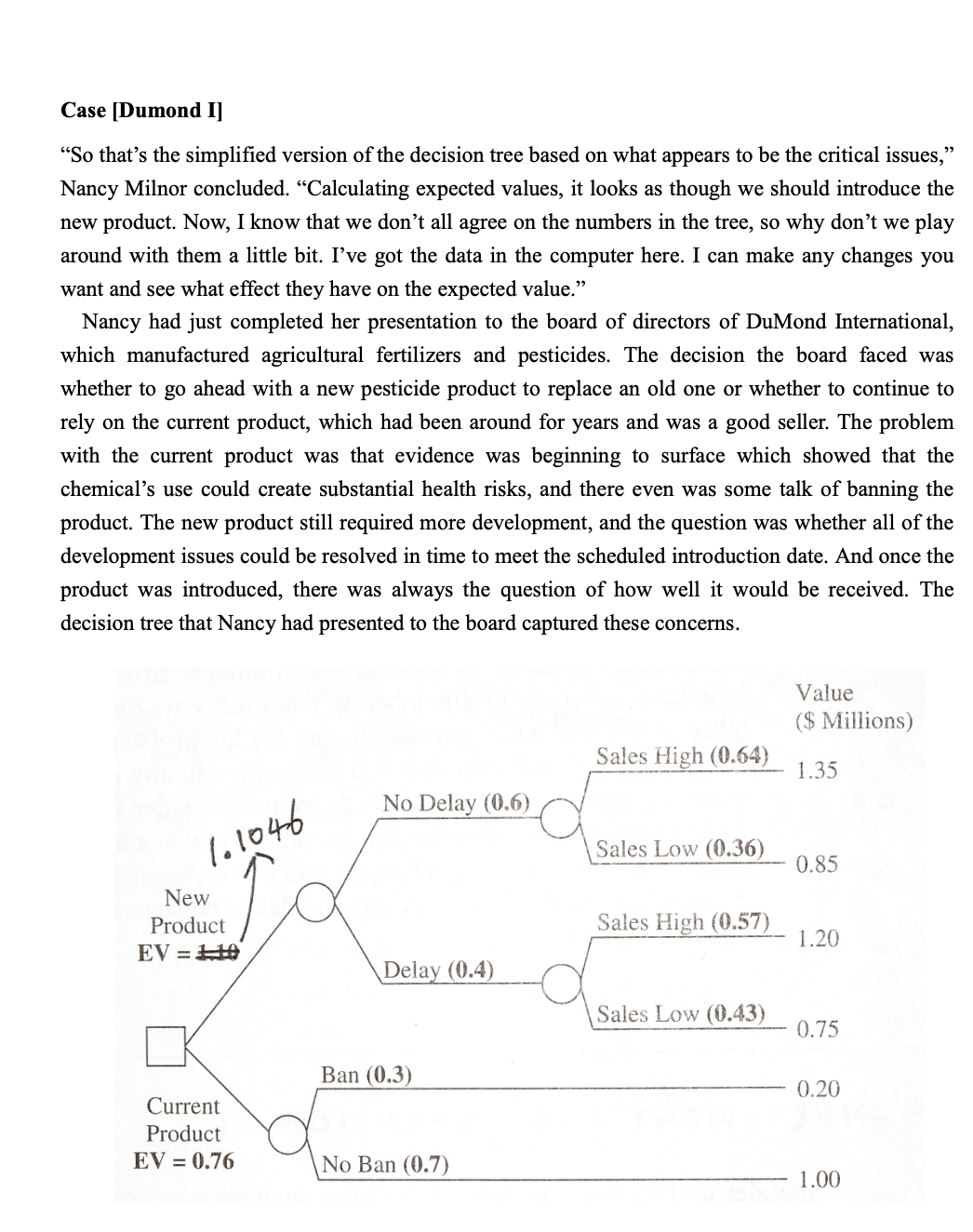Answered step by step
Verified Expert Solution
Question
1 Approved Answer
The boardroom was beginning to get warm. Nancy sat back and relaxed as she listened to the comments. Well, I'll start, said John Dilts. I
The boardroom was beginning to get warm. Nancy sat back and relaxed as she listened to the
comments.
"Well, I'll start," said John Dilts. "I don't have much trouble with the numbers in the top half of the tree. But you have the chance of banning the current product pinned at percent. That's high.
Personally, I don't think there's more than a percent chance of an outandout ban."
"Yeah, and even if there were, the current product ought to be worth $ at least," added Pete Lillovich. "With a smaller chance of a ban and a higher value, surely we're better off with the old product!"
"Well, I don't know about you two," said Marla Jenkins. "I think we have a pretty good handle on what's going on with the current product. But Id like to play the new product a little more conservatively I know that the values at the ends of the branches on the top half of the tree are accounting's best guesses based on a complete analysis, but maybe they should all be reduced by $ just to play it safe. And maybe we should just set the probability of high sales equal to percent regardless of the delay."
Steven Kellogg had been involved in the preliminary development of the new product more than anyone else. He piped up "And the delay is actually more likely than no delay. Id just reverse those probabilities so that there's a percent chance of a delay. But I wouldn't make any changes on the lower part of the tree. I agree with Marla that we have a good idea about the performance of the current product and the prospects for a ban."
"I don't think it matters," countered Lillovich. "The changes John and I suggest make the current product look better than it does in Nancy's analysis. Marla's and Steven's changes make the new product look worse. Either way, the effect is the same."
Nancy had kept track of the comments and suggested changes. She sat down at the computer and started to enter the changes. After a few moments, she grinned and turned to the board. In spite of your changes," she said, "I believe I can persuade you that DuMond should go with the new product."
Case Dumond I
Nancy Milnor had returned to her office, still concerned about the decision. Yes, she had persuaded the directors that their disagreements did not affect her analysis; her analysis still showed the new product to be the appropriate choice. The members of the board, however, had not been entirely satisfied. The major complaint was that there was still too much uncertainty. Could she find out more about the likelihood of a ban, or could she get a better assessment from engineering regarding the delay? What about a more accurate sales forecast for the new product?
Nancy gazed at her decision tree. Yes, she could address each of those questions, but where should she start?
Hint Compute the EVPI of information about delay; information about ban; information about sales; information about delay & ban; information about delay & sales; information about sales & ban; and information about delay, sales, & ban. What information is uninformative given which information?Case Dumond I
So that's the simplified version of the decision tree based on what appears to be the critical issues," Nancy Milnor concluded. "Calculating expected values, it looks as though we should introduce the new product. Now, I know that we don't all agree on the numbers in the tree, so why don't we play around with them a little bit. I've got the data in the computer here. I can make any changes you want and see what effect they have on the expected value."
Nancy had just completed her presentation to the board of directors of DuMond International, which manufactured agricultural fertilizers and pesticides. The decision the board faced was whether to go ahead with a new pesticide product to replace an old one or whether to continue to rely on the current product, which had been around for years and was a good seller. The problem with the current product was that evidence was beginning to surface which showed that the chemical's use could create substantial health risks, and there even was some talk of banning the product. The new product still required more development, and the question was whether all of the development issues could be resolved in time to meet the scheduled introduction date. And once the product was introduced, there was always the question of how well it would be received. The decision tree that Nancy had presented to the board captured these concerns.

Step by Step Solution
There are 3 Steps involved in it
Step: 1

Get Instant Access to Expert-Tailored Solutions
See step-by-step solutions with expert insights and AI powered tools for academic success
Step: 2

Step: 3

Ace Your Homework with AI
Get the answers you need in no time with our AI-driven, step-by-step assistance
Get Started


